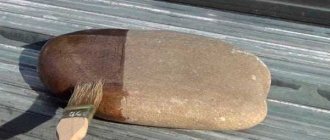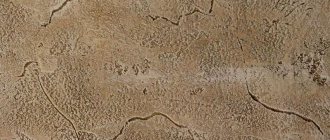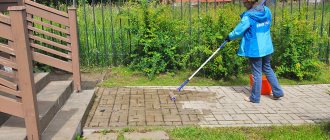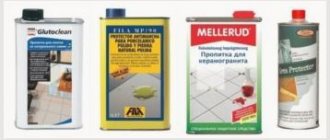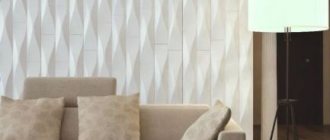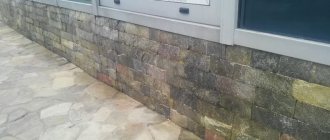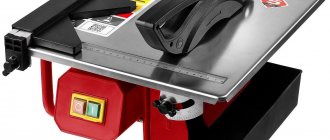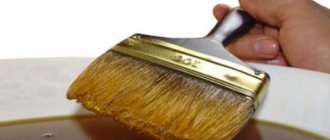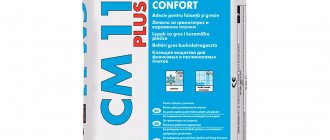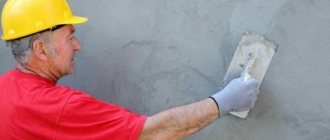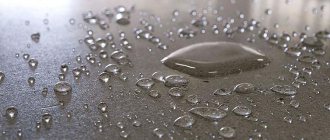Porcelain tile is a durable material that is not afraid of negative influences. Currently, porcelain tiles are used for flooring, this is not surprising, because such a material is characterized by high strength characteristics and an excellent degree of wear resistance. But to maintain the attractive appearance of the flooring and extend its service life, proper care is required.
The material itself is not afraid of contamination, however, tile joints are sensitive to aggressive environments, quickly become dirty, and in the event of strong mechanical impact, destruction occurs. Therefore, such flooring should be constantly monitored and properly cared for using a special cleaning agent.
Impregnations for the care and protection of porcelain tiles
Impregnations with wet stone effect
Impregnation to create the effect of wet stone is a chemical product that increases the aesthetic appeal of stone structures, and also prevents their destruction and extends their service life.
- Article 11130
- Manufacturer AKEMI (Germany)
- Volume, l 1
- Type Protective impregnation
- Wet stone effect Yes
- Article 9597
- Manufacturer AKEMI (Germany)
- Volume, l 5
- Type Protective impregnation
- Wet stone effect Yes
- Article 7412
- Manufacturer AKEMI (Germany)
- Volume, l 1
- Type Protective impregnation
- Wet stone effect Yes
- Article 12597
- Manufacturer ILPA (Italy)
- Volume, l 5
- Type Protective impregnation
- Wet stone effect Yes
- Article 3483
- Manufacturer ILPA (Italy)
- Volume, l 0.75
- Type Protective impregnation
- Wet stone effect Yes
- Article 15805
- Manufacturer GENERAL (Italy)
- Volume, l 1
- Wet stone effect Yes
- Article 10703
- Manufacturer AKEMI (Germany)
- Volume, l 0.25
- Type Protective impregnation
- Wet stone effect Yes
- Article 7411
- Manufacturer AKEMI (Germany)
- Volume, l 1
- Type Protective impregnation
- Wet stone effect Yes
- Article 8012
- Manufacturer AKEMI (Germany)
- Volume, l 5
- Type Protective impregnation
- Wet stone effect Yes
- Article 1145
- Manufacturer TENAX (Italy)
- Volume, l 1
- Type Protective impregnation
- Wet stone effect Yes
Benefits of use
To obtain this effect, it is not recommended to use paint, since it negatively affects the mineral structure of the product and retains its properties for a short time. Special impregnation is ideal for these purposes due to its many attractive properties:
Penetrates deeply into the pores of the material, creating a “wet” effect on the surface;
Protects against the penetration and proliferation of mold, moss, and dangerous types of fungus;
Prevents the destructive effects of moisture and other external factors;
Helps enhance the color of the treated surface;
Does not reduce the vapor permeability of the material.
The compositions are suitable for artificial and natural stone, brick, and concrete structures. Impregnation is used sparingly, its protective properties last for a long time.
Application Features
Before applying the composition, the surface must be dry. If it is wet, a whitish tint may appear and the coating may peel off. The material must first be sanded and cleaned of efflorescence and dirt. Previous coatings should be removed.
For application, use a roller, brush or spray. Before processing, you need to mix the composition well. The number of layers is determined by the desired effect, each layer is dried for at least 2 hours. Excess must be immediately removed with a cloth to avoid the formation of a sticky film.
No. 8. What should you pay attention to when purchasing?
- Before purchasing, you need to already know what size tiles you want . This way you can easily figure out their quantity by dividing the desired coverage area by the area of one tile.
- Please note that all tiles match in color and shade . All tiles must be from the same batch, otherwise the difference in shade will be very noticeable after installation!
- The caliber of all tiles should also be the same - this will ensure a beautiful, uniform installation without visible differences in size.
- Be sure to check the weight ! The recommended tiles for flooring are 8-8.5 mm thick and weigh at least 18.5 kg. Do not hesitate to clarify this point, otherwise you risk buying a fake!
- The back side of the tile can also say a lot. It should have shallow, small squares with sides of a maximum of 2x2 cm. The larger and deeper these technical notches are, the lower the quality of the material.
- Do not forget about the reserve , which should be 10% of the total number of tiles for the diagonal laying method and 5% for other methods.
- The packaging of porcelain tiles for flooring will show foot on a black background, if this sign is repeated, it means a higher wear resistance class. If you see snowflake - This is a frost-resistant porcelain stoneware.
Types and properties of coatings for stone with a wet effect
Author: Anastasia Isakova · Published 07/16/2018 · Updated 01/27/2018
Impregnation for stone “wet effect” is a unique chemical agent that takes care of the appearance of natural material and also protects it from rapid destruction. Before special impregnations appeared that created the effect of a wet stone, ordinary fat was used. Afterwards, they used products that formed a protective water-repellent film, but it quickly wore off under mechanical influence.
Types of decorative and protective coatings
Modern decorative and protective compounds intended for coating stone penetrate into microcracks in natural materials, filling them, preventing moisture from penetrating inside, and repelling water. The choice of such a product primarily depends on the functional characteristics of the stone or tile.
Wet stone effect varnish
There are a huge number of impregnations that differ in their chemical compositions and physical properties. These substances are very popular in the construction industry. For decorative finishing of natural stone, varnish is used. A specific protective film is formed on the surface of the mineral composition.
The surface of a natural material treated in this way acquires a distinct color saturation, and moisture does not get into the microcracks of the surface. Saturation can be achieved through simple finishing procedures, simply applying the varnish to the surface with a paint brush.
A varnish with a “wet stone” effect must be chosen correctly, taking into account the operational characteristics of the stone. Otherwise, you may not get a high-quality and long-term effect. Features of choosing a varnish to create a wet effect:
- For exterior work, special varnishes with enhanced functionality are used. The product must withstand temperature changes, increased mechanical stress, precipitation and ultraviolet rays as efficiently as possible. Using such means you can treat the surface of paving slabs and a façade lined with brick.
- Finishing stone indoors requires minimal protection. The main thing is that the varnish can withstand the microclimatic conditions of the room. This composition is suitable for tiles in the bathroom or natural stone, decorative columns in the corridor, hallway.
- Acrylic varnish has universal properties. If acrylic is water-based, then it is better to use it indoors, on a surface with minimal mechanical impact. Solvent-based acrylic varnishes are suitable for external finishing work, as they are characterized by increased toxicity and durability.
It is not advisable to treat sidewalk surfaces with varnish. Varnish is best used for painting facades, columns, and finishing elements of a building. Otherwise, you will have to frequently restore the surface.
In the video: using an organic-based wet-effect varnish.
Impregnation with high mechanical load
For paving slabs or tiles that are laid indoors on the floor, special compounds are used. Most often this is an impregnation with a wet stone effect. It is not recommended to use conventional dyes - this can spoil the mineral complex of the product.
Features of impregnation for paving made of natural materials:
- simplifies the procedure for maintaining the base;
- increases the service life of the coating;
- seals seams and joints between tiles;
- impregnation is used as an anti-slip agent;
- does not expose the surface to mold and mildew;
- wet-action impregnation is not exposed to aggressive chemicals.
If you treat paving slabs with an impregnating compound, they will acquire an interesting appearance, their service life will increase, and the wet effect will make the finishing material unique.
During the processing process, it is necessary to fulfill a lot of conditions in order not to damage the building material, to make it more durable and aesthetically attractive. Thus, paving slabs and indoor tiles must be of a special type, since not all surfaces can be impregnated or covered with this type of varnish.
In the video: water repellent for granite slabs EC-77 - wet effect and protection.
Application of water repellent
It is recommended to apply impregnation no earlier than 7 days after grouting, so that the surface is completely dry. In rare cases, impregnation can change the color of the grout, so to avoid unpleasant surprises, it is better to carry out a test treatment in a hidden area.
The processing temperature recommended by the manufacturer is indicated on the packaging. However, there are general requirements: processing must be carried out at a temperature not lower than +5°C and not higher than +30°C and a relative humidity of at least 80%. Therefore, when working with such solutions in rooms with high humidity (bathroom, sauna, swimming pool, shower), it is necessary to clarify the indicators using a hygrometer.
Applying water repellent to seams
Protective impregnation with water repellents is carried out with a thin brush, carefully along the seam. If the solution gets on the tile, its surface may become cloudy. To avoid damage to the finish, it is recommended to seal the edges of the tiles with masking tape. Water repellents may penetrate into the grout, so a second coat will be required to provide a water-repellent finish.
Instructions for use
Impregnation or varnish is sold ready-made. If a more liquid composition is required, the substance can be diluted with a regular solvent. To perform painting, you should additionally purchase a paint brush. A roller will not work, as it will not allow the substance to penetrate into the small pores of the material.
To prevent the stones from being damaged during processing, it is worth carrying out the work in accordance with certain instructions:
- The surface to be treated must be free of debris and dust. You can sweep the area, but the best solution is a vacuum cleaner. Very dirty areas will need to be washed.
- Be sure to dry the brick, stone or tile base, since the varnish does not stick to wet stone, and subsequently does not dry.
- Several thin layers of the composition are applied at regular intervals. If the previous layer has not yet dried, then the next one cannot be applied.
- Brick and porous tiles sometimes require several additional layers of coating. They also need to be applied evenly.
- Let the treated tile stand for a while so that the coating is completely fixed, saturating all microcracks and chips. The required time for fixation is two weeks.
As a result of quality work, a rich color is obtained, and the coating segments become wet. Thanks to impregnation, the conditions for using coatings and decor made from natural materials are improved. The mineral composition of the stone and its properties are preserved, and geodesy is improved. Any person who does not have special skills and experience in repair work can cope with the application of the material.
How and how to cover wild stone on a stove or fireplace (1 video)
No. 9. Features of laying porcelain stoneware
If you decide to refuse the expensive services of professionals and decide to install porcelain stoneware yourself , you should approach this issue very carefully, because the durability of the coating will depend on the correct installation.
Porcelain stoneware, as a very durable material, is very difficult to cut, so that you do not have any difficulties or surprises during the installation process, prepare all the necessary tools :
- You will definitely need a tile cutter or grinder
- Required building level
- A spatula with a smooth edge is for applying the adhesive mixture and a spatula with a serrated edge is for removing excess mortar.
- A construction bucket or other convenient container for mixing the adhesive mixture
- Drill and special construction mixer to facilitate the mixing process
- Water container
- Rubber hammer
- Plastic crosses, which regulate the width of the seam, are chosen to your taste
Since porcelain stoneware is very heavy, it is necessary to choose a mixture that will withstand heavy loads. It is better to choose a plastic adhesive mixture with high “tenacity”; in addition, it prevents the tiles from falling off if your house is not yet fully settled and “walks” when temperatures change or the foundation settles. When the adhesive mixture is selected, move on to the next step.
Surface preparation
Although porcelain stoneware provides for differences of up to 15 mm, it is better to pre-level the surface by pouring concrete, pre-waterproofing, and then carefully prime it . If porcelain tiles are laid on a heated floor, then the sequence will be as follows - waterproofing the room, laying a heated floor, pouring concrete (screed), impregnating with soil, laying porcelain tiles. By the way, installation on old wooden floors is not allowed . After preparing the surface, you can proceed to the mixture. Stir the adhesive mixture according to the instructions on the package. If you are laying tiles for the first time, you should not mix the whole mixture at once, in case you will have difficulties in the process, and the mixture does not retain its adhesive properties for so long. It’s better to start by diluting a small amount, literally a couple of tiles, and try to lay them, thereby testing your capabilities.
Description
Impregnation water repellent for stone looks like a liquid, which includes a mineral dye, a binding element. Compared with coloring agents, the impregnating agent not only imparts color, but strengthens the properties of the material.
It impregnates the stone base inside and binds to its structure, resulting in a change in shade, and the surface receives protection from moisture, wind, ultraviolet radiation and biological formations.
Impregnation for marble and natural stone and other types is distinguished by its ability to be used not only for facade work, but also to eliminate traces of corrosion and salts. What will be used as constituent substances depends on the type of product; as a result of processing, a transparent film is obtained on the stone.
Glazed
This type is closest to regular tiles: both varieties are covered with a layer of glaze on top. Smaltgranite is produced using double pressing technology, clay is pressed with dyes and glassy enamel, the result is a stunning color palette.
Glazed porcelain tiles are not suitable for public places; they have a strong backing and high-quality enamel, but the two-component material is not as durable as monolithic types.
Why is impregnation needed?
To understand whether it is worth using wet stone impregnation, you should consider factors that negatively affect the properties of stone or brick foundations. The following problems can be identified:
- Stone requires protection from external influences not only on the street side, there are also harmful factors indoors. Chemicals, damp exposure, paint can damage the material and stains may form on the coating;
- The brightness of the material suffers from ultraviolet radiation, fading;
- Mold, moss and fungal areas form, which can destroy the base;
- White marks form, which gradually destroy the base.
Impregnating agents create a film coating that does not allow wet elements to pass through, increasing the durability of the structure and preserving the appearance.
Characteristics
Impregnation can be used not only for its protective properties during external treatment; a large number of different options have been created that have different characteristics. These differences are achieved by including different constituent elements.
This is how the composition is applied to reduce the impact of friction on countertops, window sills and other objects. This is a good way to preserve the decorative properties of a product longer.
Impregnation for porcelain tiles with a wet stone effect protects and gives a brighter color to the stone. Some products are absorbed deeply into the material; as a result, external influences cannot penetrate further into the base and do not affect its structure.
The stone will be protected from sunlight, and the richness of the shade will remain for many years. Strength characteristics increase.
Latex impregnations are available for sale, which provide reliable protection for the material even in harsh operating conditions.
Impregnation for artificial stone can also be used. Selected for paving stones, limestone and other substrates. Varnish impregnations are considered universal and are applicable for various types of stone products.
Porcelain tiles – raw material base, production technology
Despite the “telling” name, porcelain stoneware, it is not a derivative of granite; rather, we are talking about the characteristics of the tile, similar to the properties of this rock. The raw material for the manufacture of cladding is a mixture of natural components.
- White clay (kaolin) is a binder that increases the fire resistance of the material.
- Illite clays are plasticizers, prevent cracking of the mass and increase the strength of the tile.
- Quartz sand is a filler that is also responsible for the strength characteristics and hardness of the tiles.
- Feldspar – increases hardness and makes the tile surface resistant to chemicals.
- Additives – modifying and mineral substances, pigments.
All components are pre-crushed and mixed until a homogeneous powder is obtained. The powder mass is molded by semi-dry pressing under a pressure of 400-500 kg/cm², after pressing and drying the workpieces are fired in an oven at temperatures up to 1300⁰ C. As a result of pressing and firing, the raw material mass is converted at the molecular level into a homogeneous monolithic structure without pores, delaminations and foreign inclusions. Depending on the type of porcelain tile, the production cycle may also include glazing, structuring or grinding/polishing.
Advantages and disadvantages of various impregnations with the “wet stone” effect
Any material has positive and negative sides, so before deciding whether to use impregnation, all aspects are studied. The advantages include the following properties:
- A layer is created that does not allow moisture to pass through, which preserves the integrity of the material for a long time;
- A number of types of stones are susceptible to rust; impregnating agents can prevent this negative effect;
- Chips and cracks do not form in the inner part of stone products;
- The basement and foundation will not suffer from moisture after using the products;
- The appearance of the product improves, the color becomes richer;
- You can carry out the treatment yourself, the process is simple;
- Safety of the composition for human health.
One of the disadvantages is the relatively high cost of the products, which is justified by the protective properties obtained.
Types of decorative and protective coatings
To choose the right type of impregnation, you need to understand what their differences are. The characteristics of the stone material itself and its features are also important in order to provide maximum protection from external factors.
Wet stone effect varnish
Most often they prefer to choose varnishes that create the effect of wet stone, while simultaneously creating a reliable barrier against harmful influences. When choosing, you can focus on the following features of the funds:
- To work from the street side, it is necessary to use reinforced varnishes that can withstand temperature changes, sunlight and other natural manifestations;
- Interior decoration does not require strong protection; there are fewer factors affecting the stone;
- Acrylic-based products are distinguished by their versatility. The water-based option is suitable for work inside the building, while the thinner-based version is more effective and can be used outside the building. Silicone types are also popular.
Impregnation with high mechanical load
To work with sidewalks and flooring, it is necessary to use special compounds. You should not apply standard paints; they can damage the stone coating. Special impregnations have the following characteristics:
- Maintenance of the structure becomes easier;
- Increases durability;
- Covers seam and butt areas;
- Reduces surface slip;
- Protects against biological formations;
- Withstands chemical elements.
Not all types of tile material can be used with these impregnations; it is important to study the instructions with the purpose of the composition in advance.
No. 4. Classification of porcelain stoneware
- Size. The most popular sizes of tiles for flooring are square tiles with dimensions of 300x300 mm, 450x450 mm and 600x600 mm. If you have some kind of designer and unusual project in mind, and the floor will be the center of your interior, then you also have at your disposal tiles of the smallest size - 50x50 mm, and non-standard sizes - 200x200 mm, 150x300 mm, 300×450 mm, 300×600 mm, 400×400 mm. If you still haven't found the right size for you, you can get it using waterjet cutting .
- Caliber is the amount of permissible discrepancy in the size of the tiles, which is 3-5 mm. During the heat treatment, the edges of the tiles are slightly deformed, so they may differ from each other. To avoid large discrepancies in size, the tiles undergo a process of rectification , that is, trimming the edges using special equipment. match perfectly during subsequent installation .
- Thickness. The maximum thickness of porcelain stoneware is 30 mm, the minimum is 3 mm. With proper installation of a 3 mm thick floor covering, its strength and wear resistance are in no way inferior to a 30 mm thick covering, so there is no point in giving preference to the thickest, and therefore more expensive, porcelain stoneware. For example, recommended specifically for flooring, 8.5 mm , can withstand a load of 200 kg/cm2.
Abrasion class. Abrasion (wear resistance) is the main technical characteristic of porcelain stoneware. Depending on the degree of load and mechanical impact, there are 5 main classes of abrasion:
- PEI I, PEI II – for rooms with low traffic in soft shoes (bathroom, toilet);
- PEI III - for residential premises with an average level of traffic, without access from the street or yard (balcony, kitchen, hallway);
- PEI IV – for public spaces with high traffic levels;
- PEI V – for premises with any level of traffic and mechanical impact.
For example, for the floor covering in the entire apartment, abrasion class III is quite sufficient, and for the bathtub and toilet, class I or II can be used. If your task is to choose porcelain tiles for a private home, then choose class IV for the hallway, and for the porch give preference to class V, which is also frost-resistant. In other rooms, class III will also be sufficient.
Instructions for use
Impregnating agents are sold ready-made and can be immediately applied to the base. For application, select a brush; it will be able to thoroughly saturate the entire surface. Stages of work:
- The surface is cleaned of all types of dirt.
- Wait until the base is completely dry.
- Using a brush, treat the surface in several layers, each one should dry well before the next one.
- Complete drying may take 14 days; the base should be protected from moisture in the first 13-14 hours.
Tips for using impregnation
The technician must wear rubber gloves and safety glasses while working. If the product gets on the skin, the area is thoroughly washed with water. After applying the product, residues are not allowed to be stored; they are disposed of. The best weather conditions are considered to be +11 degrees and humidity over 67%.
Treating the surface of the stone with impregnating agents helps improve its properties and extend its service life. The application process is simple, so you can do it yourself. When choosing a composition, the operating conditions and the type of stone base are taken into account.
Manufacturers
When choosing a collection, it is better to prefer European-made products. Europe is home to leading factories that use time-tested technologies and innovative equipment. Among the producing countries, the leaders are Spain, Italy, Germany and Portugal. Hundreds of series of porcelain tiles are produced here, each of which presents samples with a unique design solution and ideal geometry.
On a note! Among the most famous brands are the Italian KERAMA MARAZZI, CASA DOLCE, the German MEI, the Spanish OSET, the Portuguese GRES TEJO, as well as the Russian KERRANOVA and Uralkeramika.
14
